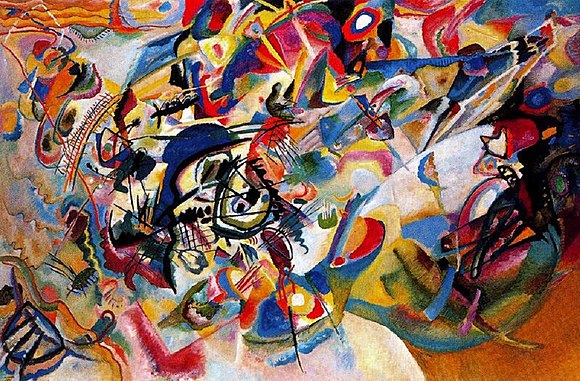Abstract artworks diverge from depicting recognizable scenes or objects and instead use colors, forms, and lines to create compositions that exist independently of visual references from the natural world. This movement, which gained momentum in the early 20th century, was propelled by artists such as Wassily KandinskyWassily (Vasily) Kandinsky (1866 – 1944) is known as one of the pioneers of abstract modern art. He was born in in Moscow to upper-class parents of mixed ethnic origins. At an early age, Kandinsky showed a rare sensitivity towards music and the arts, which his father strongly supported. Kandinsky decided to study law, ethnography, and economics, and started successfully More, Piet Mondrian, and Kazimir Malevich. These artists aimed to explore spiritual, emotional, and intellectual themes through their abstract art paintings.

Wassily KandinskyWassily (Vasily) Kandinsky (1866 – 1944) is known as one of the pioneers of abstract modern art. He was born in in Moscow to upper-class parents of mixed ethnic origins. At an early age, Kandinsky showed a rare sensitivity towards music and the arts, which his father strongly supported. Kandinsky decided to study law, ethnography, and economics, and started successfully More, Composition VII (1913)
The variety within abstract art is broad, spanning from the geometric abstraction seen in Mondrian’s structured compositions to the expressive abstract paintingPainting is a fundamental form of visual art that has been practiced for thousands of years. It involves applying pigment to a surface such as canvas, paper, or a wall. Painting can be explored through various styles, techniques, and mediums, each offering unique possibilities for expression and creativity. Historical Background • Ancient Beginnings: The history of painting dates back to More styles of Kandinsky. This genre asserts that art can convey universal truths without mimicking reality, using elements like abstract art with lines to evoke feelings or ideas.
Abstract artwork is typically categorized into two main types: geometric abstraction, which utilizes geometric forms and structures for a calculated, orderly appearance, and lyrical abstraction, which prioritizes spontaneous and intuitive color and shape application to express emotions or atmospheres. Mondrian’s work exemplifies geometric abstraction, employing a restrained palette and simple shapes to achieve balance and harmony. In contrast, Kandinsky’s abstract colorful works are more aligned with lyrical abstraction, using vibrant colors and fluid forms to reflect the artist’s emotional state or environmental responses.

Piet Mondrian Composition No. 10 (1939-1942)
The influence of abstract art extends deeply into modern and contemporary art, challenging viewers to engage with artwork abstract paintings on a more interpretive level. This engagement encourages a deeper examination of the visual elements and the emotions or ideas they represent, establishing abstract art work as a crucial component of modern artistic expression. From mid-century abstract paintings to modern abstract art paintings, the evolution of this genre continues to inspire and provoke thought, cementing its place in the art world.
Sources:
The Spiritual in Art: Abstract Painting 1890-1985 by Maurice Tuchman. This book offers a comprehensive overview of the spiritual motivations behind the emergence of abstract art, featuring discussions on Kandinsky, Mondrian, and Malevich, among others.
Piet Mondrian: Life and Work by C. R. P. Seuphor. This biography of Mondrian offers a detailed analysis of his artistic evolution, his contributions to De Stijl, and his influence on the course of abstract art.
Kazimir Malevich and the Art of Geometry by John Milner. This book explores Malevich’s Suprematism, focusing on the geometric forms and the philosophical and aesthetic theories that underpinned his abstract works.<
Abstract Expressionism―and Beyond: American Painting in the Collection Reinhard Ernst. This book showcases a diverse array of postwar abstract art in the United States, drawingDrawing is a foundational art form that involves creating images on a surface, typically paper, using tools such as pencils, pens, and charcoal. It is a versatile medium that allows artists to express ideas, emotions, and stories through lines, shapes, and shading. Historical Background • Prehistoric Beginnings: The earliest known drawings date back to prehistoric times, with cave drawings found More from the Museum Reinhard Ernst’s collection to explore the evolution of abstraction from the color field paintings of Helen FrankenthalerHelen Frankenthaler was a trailblazing American artist known for her contributions to Abstract Expressionism and Color Field Painting. Her innovative techniques and use of color significantly influenced the development of modern art in the mid-20th century. Early Life and Career Helen Frankenthaler was born on December 12, 1928, in New York City. She studied at the Dalton School and Bennington More to Julian Schnabel’s plate-paintings. Featuring over one hundred color illustrations of works by forty-five influential artists, the catalog provides a comprehensive look at the variety of aesthetic approaches within abstraction, highlighting the dynamic interplay between improvisational forms, geometric compositions, and the sublime use of paint and color.
Abstract Painting: The Elements of Visual Language by Jane Davies. This book provides an in-depth exploration of the fundamental visual elements—line, shape, pattern, texture, depth, and color—that form the basis of paintingPainting is a fundamental form of visual art that has been practiced for thousands of years. It involves applying pigment to a surface such as canvas, paper, or a wall. Painting can be explored through various styles, techniques, and mediums, each offering unique possibilities for expression and creativity. Historical Background • Ancient Beginnings: The history of painting dates back to More, aiming to enhance the artist’s awareness and ability to critically assess their work without bias. With over 200 color illustrations, the book offers a comprehensive guide to developing a more expressive and authentic approach to artistic expression, encouraging a new perspective on viewing and understanding one’s own paintings.
